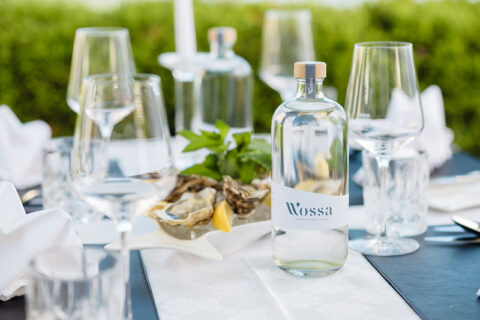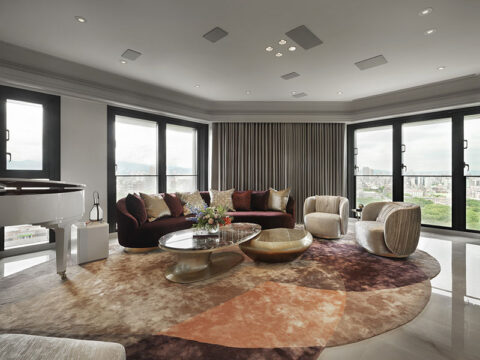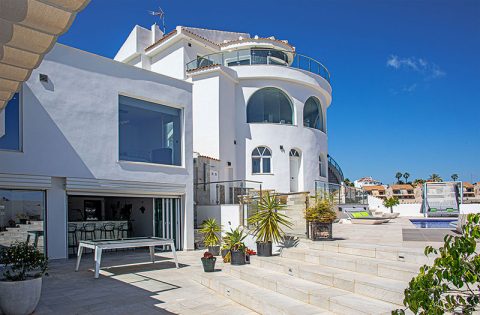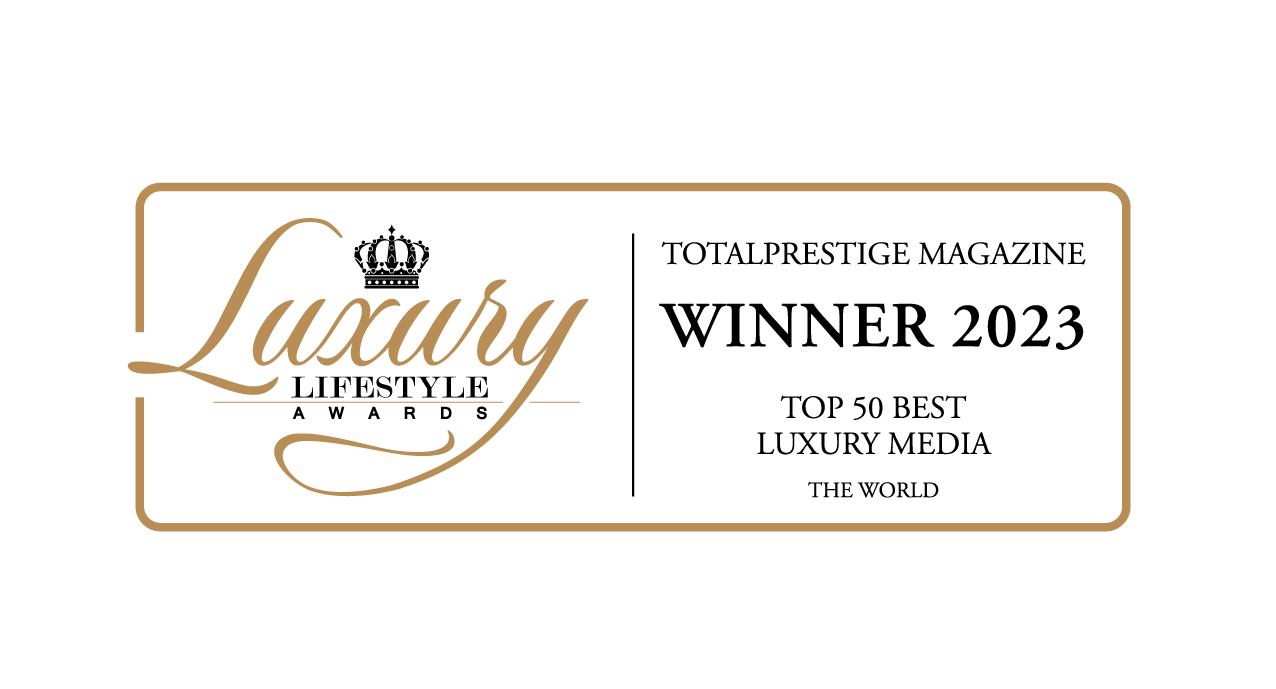Vin Lee has built Grand Metropolitan into the premier luxury goods holding company in North America. With over 120 brands under the Grand Metropolitan umbrella, Lee has worked diligently since opening the company, and he has built it piece by piece. Grand Metropolitan has become synonymous with luxury brands, and so has Lee.
Starting his career in the 1980s in the hospitality industry, Lee was tasked with turning around a golf resort in Northern Michigan, while still too young to legally drink. The experience led him to other areas and industries including jewelry.
Lee has also taken an incredible journey that has led him down numerous paths. Each one has led to the next with Lee grabbing the opportunities in front of him and running with them.
More often than not, the “King of Luxury” has succeeded in his journey. The path Lee is currently on has been his most successful and he has put years of blood, sweat and tears into it.
Vin, in a previous interview you stated you built your company, Grand Metropolitan, while flying from coast to coast. Firstly, how did you get the inspiration for your business and secondly, how difficult was it to create your vision while traveling and working on other business interests?
VIN LEE: The culture of the business world as I was coming of age was the era of the great American conglomerate. Diversification through mergers and acquisitions funded by debt was a way of life. And it was promoted and immortalized in pop culture and mainstream media like Wall Street, Barbarians at the Gate and Pretty Woman. Even Goodfellas and the Godfather films had their undertones about borrowing and diversification. I am afraid I am a product of the culmination of those times. In 1988, my first year of college and business, men like Bernard Arnault (LVMH), François Pinault (Pinault S.A.) and Johann Rupert (Richemont) were assembling their luxury goods empires.
It was a period of conspicuous consumption perhaps not seen since the Roaring 20s, but with an added bonus. Mainstreaming of credit cards was like jet fuel on spending, consumer as well as corporate. Television’s Lifestyles of the Rich & Famous was showing you the gold paved sidewalks of Rodeo Drive and in South Florida the police are driving Ferraris and wearing Rolexes on Miami Vice. It was a lot sexier than the sleepy suburbs of Detroit where “keeping up with the Joneses” is measured in snow blowers, bake sales, and PTA meetings. My first real sports car was a 1989 Mercedes 560SL. There wasn’t a Ferrari dealership in the state then. You had to be sensitive to where you parked to not upset employees of the Big three automakers at the Renaissance Center in downtown Detroit.
I had some modest success with my first business, Cinemagic Marquee, patenting a design for mechanical billboards in the late 1980s, but it wasn’t until I was contracted to turn around $80 million in debt in one of the region’s most prominent golf and spa resorts that I had my first taste of the world of luxury. Wishing to celebrate upon the signing of what would be a multi-year $50m contract, I set out to purchase a Rolex President. Ultimately, I ended up investing in the fine jeweler as well as a handful of other high profile enterprises around town. I felt that if I were to invest the profits from the resort into established cash positive businesses I would be able to pursue a lifestyle I had only seen on television and in the movies.
Throughout those early years, floundering to find direction with my patents in one hand and outsized ambition in the other, I had opportunities to meet some of the most successful men in business. Sumner Redstone, H. Wayne Huizenga, A. Albert Taubman and more allowed me momentary glimpses into the world of billionaires. All of whom were successful in many businesses simultaneously. It is quite an exclusive club to be in. Although my aspiration was not to be in the club, but to own the clubhouse, and play host to those members.
Just before the turn of the century, three iconic retailers began to default on their overextended credit facilities, Montgomery Wards, Service Merchandise, and Heilig-Meyers Furniture. As bankruptcy loomed for all three companies, I began conversations for the IP being brokered. Service Merchandise at the time was the second largest jeweler in North America with Heilig-Meyers not far behind selling over $400m a year from its furniture stores. Now, while Wards is hardly Macy’s and Service Merchandise was not Cartier, Heilig-Meyers was the world’s largest furniture retailer with a century old legacy and annual revenues of around $2 billion.
By way of Atlanta, Georgia, I found myself in South Florida being drawn into both the cigar and golf industries while attempting an industry roll-up in the beleaguered jewelry industry starting with Samuels Jewelers. I suffered over two years through my efforts to acquire what was then one of the top 10 jewelry retailers in America boasting $114m in revenue from about 120 locations. I was not successful.
Many people don’t realize Ybor City, Florida is in fact the birthplace of the North American cigar industry while Miami is replete with tobacco artisans and exotic luxury from around the world. I was seduced into the world of diamonds and its dangerous history, but my relationship with cigars has been much more romantic. It is a masculine industry steeped in tradition and culture. Unlike the $100bn fine jewelry market, premium cigars make up only about $20bn in annual sales. But like fine jewelers, the cigar industry is made up of a few large players and thousands of independent labels. The Beverly Hills Cigar Club and its private label cigar LOUIXS became my saving grace after the failure with Samuels Jewelers.
The tennis earring (ear climber), my signature jewelry, started gaining traction on the red carpet. I soon found myself flying between both coasts every few weeks, a jet as my home. Over the next two decades, we acquired dozens of incredible luxury brands with emphasis in jewelry, home furnishings, and fashion from Rodeo Drive to Moscow.
Like all great entrepreneurs, it took Lee some time to turn Grand Metropolitan into the success he dreamed it would be. In a time when social media and quick fix advertising didn’t exist, Lee had to build his company from the floor up, one brick at a time. The building of the company was much slower than today’s lightspeed world in which businesses pop up overnight before being sold to larger corporations.
You have said in the past that today it is much easier to build a business. For example, an app can be created and in no time the creators can begin raising funds. Tell me about the struggles you faced as a young entrepreneur and getting Grand Metropolitan and other ventures off the ground.
VIN LEE: One of my closest friends developed an app for the cannabis industry that allows you to find the products or blends you are looking for in your area. He created it over a weekend and soon sold it for a great deal of money. Another, a graphic designer, created promotional material for a startup which was quickly acquired by AOL making him a millionaire. I was born a decade too late and a decade too early. I spent the ‘80s and ‘90s studying cigars, cognac, and sports cars. I couldn’t even type until 1998.
Grand Metropolitan is a holding company for our 130 legacy portfolio brands that have achieved over $250bn collectively since their founding. Certainly, one cannot assemble that type of operation overnight even if you had started with $3bn in capital. It took me three decades. Obviously, dozens of companies, specifically tech, started by founders half my age have been able to create enterprises 100 times larger in a matter of a few short years. Public markets and venture capital help create these institutions leaving founders power and control diluted. Being privately-held can be very challenging when wanting to grow through acquisition. I abhor debt-financed expansion. So, every deal has to be paid for out of profits. It is how I sleep well at night.
In preparing for this interview I was going through some old files. The Montgomery Wards bankruptcy offering included their SMARTsuite software with an enterprise cost of over $100m. Fifteen years later, you can sign up for Amazon or Ebay for free to use their platform and systems, while companies like Wix, Weebly, and WordPress offer free templates for tens of thousands of designs and functions. The execution of an idea is easier and more affordable than ever.
When I started Cinemagic Marquee, I spent $800 on business cards and letterhead that I designed myself and I was the only employee. Office computers were $6,000 and little more than glorified word processors. I recently went without internet for almost a week and practically went nuts. Back then, we didn’t know what we didn’t have.
As for my start, I didn’t have a lot of struggles in the beginning. My efforts as a teenager gave me both the finance and confidence to follow my ambitions. It wasn’t really until Grand Metropolitan caught up to my goals which required me to reach further that it got hard. Purchasing local merchants or small brands is much easier than combatting bankruptcy courts or entrenched managements who are responsible for drowning shareholders and employees in debt.
The real challenge is in sticking to the path you have chosen. To maintain resolve with your goals. I had this vision of how I wanted my life to be, who I wanted to become. Along the way, there are many temptations that try and draw you from your mission. Relationships with family, friends, and lovers are really difficult to maintain when your ambitions pull you physically and emotionally away from them. The higher you go, the lonelier it is.
Lee can thank his parents and their support for his interest in luxury. He benefited from the encouragement he received at home and used it to fuel his ambitions for the future. Lee has seen luxury evolve over the course of his life and career. What was luxurious and must have at one time is now seen as something outdated. He has spent years staying up to date on trends and continues to do so to drive Grand Metropolitan forward.
For 30 years, you have been redefining luxury. What is luxury to you and where does your passion for the industry come from?
VIN LEE: For most of my life I have participated in the luxury industry. I grew up in one of the wealthiest counties in the United States. Many people had summer homes and very comfortable lifestyles. Not lavishness like Beverly Hills or Bel Air, but subtle comforts. My parents were always encouraging my brother and I to have new experiences. They supported my passion for fine art enthusiastically through to college. We were introduced to sports cars and private coaches at a very early age and my first ride in a helicopter was around 10-years old.
Luxury is very complex to define as it continues to evolve and even contradict itself decade over decade. I was just watching an old movie this past weekend about how RJR Nabisco spent half a billion dollars on a line of smokeless cigarettes in the late 1980s. Now, consider that 30 years later, vaping, which is essentially smoking without the cigarettes is a multi-billion dollar phenomenon that completely contradicts what we once perceived as the detracting factor.
Another example as it pertains to leather and fur, once the pinnacle of the fashion industry, now most shun the process for its abuse of nature. Although still cherished amongst certain generations and cultures, it has dwindled out of favor in North American department stores and specialty retail clothiers.
Luxury is often considered a function of supply and demand. If I told you that one day Coca-Cola will fall into the category of luxury, you would certainly laugh. Until you realize that it now costs you $7 for a soda pop at the movies. In light of the push for a healthier diet, companies like Coca-Cola have made their packaging smaller while simultaneously increasing the prices. You are able to buy a 2 litre bottle for $1, while now paying $2 for a 20 ounce. The price of a can of Coke in the small islands of the Caribbean can go up to $12. Cheaper than the rum. That sounds like a luxury to me.
When I was younger, luxury was defined by fancy watches, exotic cars, private jets, and enormous estates. I think there is a certain push in our culture that attempts to materialize success or wealth in that manner. If you are fortunate enough to succeed to a level where you can purchase anything you desire, you lose ambition for those things. It becomes more about quality of life and preservation of that quality. I believe one’s personal definition of luxury also matures in the same manner. A good night sleep for me is far more precious than the thread count of my sheets.
I enjoy the quality of luxury items privately now over the attention they once gave me. Most people who buy a Rolex watch do so in order to impress others rather than an actual appreciation of the craftsmanship and legacy associated with a fine time piece. People who spend $500 on a bottle of wine to impress the room without having a sophisticated enough palate to appreciate the vintage. I am now much more in the latter category than I once was.
Lee’s career is unique in that each career path he has gone down has led him to some amazing new adventures. From one place to the next, Lee’s career has been like points on a chart with lines drawn to connect them all.

Your first entrepreneurial adventure was in the jewelry sector. What did your work in jewelry teach you and how have you used those lessons in the years since?
VIN LEE: Actually, my first professional experience was in the hospitality industry in turning around the Grand Traverse Resort, a luxury golf and spa resort in Northern Michigan, when it was in bankruptcy to the tune of over $80m and counting. I wasn’t even old enough to legally drink in one of the resort’s five restaurants and bars. It was from that project that I was introduced to the world of diamonds.
When I first invested in the jewelry industry, I took an office in the back of one of the showrooms that was closest to my house. The business had been there for over 50 years, with the most recent 20 being from the owner I had purchased it from. My office had stacks of industry publications going back decades. I spent probably two years reading through generations of transactions and industry trends in those trade magazines. I received an outsider’s perspective from a macro and micro point of view. A PhD in an extremely dysfunctional industry with a messaging problem.
What is different from the jewelry industry from most retail is that it really is a micro market unto itself. Most of the 26,000 jewelers in North America are owned by independent business people, often second, third, or fourth generation artisans. Many of the corporate managers and staff of the multi-location firms are professional retail managers not pure play jewelers. Rarely, the two shall meet.
Lee’s career began in the 1980s. It was time when luxury was being advertised everywhere. The decade, especially by the end of it, had become a time of living fast and buying whatever you desired. It was a defining moment, especially in the United States, that is remembered fondly by many through ‘80s revival music, television and movies today.
Many Americans are fascinated with the 1980s and it is the decade you started your career. The decade was a time of Wall Street, drugs and a change in the world that is still felt today. How did the 1980s change luxury and the way people spent their money on luxury items?
VIN LEE: Being a child of the 1980s, I am not sure what is left of it today. It was a time of conspicuous consumption and people celebrated being successful. Only the strong survived. That type of thing. It was also a time of the hyperextension of credit poured into a big milkshake of instant gratification. You had an entire generation getting a flurry of credit cards in their teenage years, even if they were unemployed. Those were the same people that borrowed their way through college and leased a new car for graduation. This was also the first generation to grow up with the concept of “condominiums” that found strong footing in the late 1960s. This was the advent of the phenomena called “entitlement”.
Baby Boomers had everything they wanted, but the Gen Xers wanted more and they wanted it now. This has caused a subsequent ripple effect to younger generations not wanting the stress associated with the trappings of wealth and luxury. You will see the younger generations pushing towards the sharing economies for homes, cars, even entertainment and clothing. Whereas previously, it was about accumulation of luxury items that led consumer spending.
Today, there is a movement toward responsible and sustainable products. The story behind the source components for a luxury good are just as important as the history and influence of the brand. Starting with cosmetics in the 1980s and animal testing, to the entire foie gras industry, and leading up to sustainability in caviar farming. Consumers want to be proud of the products they participate in from conception to consumption.
Does the term luxury mean what it once did and how does Grand Metropolitan go the extra mile to present something that is an elite product to buyers?
VIN LEE: I actually believe that the term luxury has been watered down in an attempt to upsell consumers. It has become a buzzword confusing the marketplace by trying to elbow out quality craftsmanship of superior commodities for a higher price point and immediate delivery. I prefer “aspiration” to “luxury” as the items in our portfolio are not inclusive, but exclusive. We have no intention of being all these to all people. I would prefer to spend more time polishing showroom windows from the nose prints pressed to see what’s inside.
Cigars have been around for quite a while. They were often priced the same as candy (5 cents) and as widely available. United Cigar Stores boasted 3,000 locations a century ago. The cigar was often a symbol of success or celebration. Today, it still carries much of the same cache, but one can pay hundreds of dollars for a truly fine cigar and UCS sells to many people worldwide from a single website. Our Beverly Hills Cigar Club’s private cigar LOUIXS holds a Top 10 spot in the cigar world and is only available to BHCC members.
A century ago, like cigars, lobster was so cheap and prevalent it was used as fertilizer and canned as a military staple. Eating lobster was actually considered a mark of poverty. Today, along with caviar it is one of the most decadent delicacies around the world. Pushkin Caviar is currently only available at VIP and red carpet events around the world. If you aren’t on the list you cannot partake.
Exclusivity for aspirational brands is vital. Being everything to everyone essentially equates to being nothing to no one. In the 1970s, Halston was one of the most coveted brands in the fashion world. His work was featured on every who’s who famous women from Jacqueline Kennedy to Elizabeth Taylor and Lauren Bacall. In 1983, he signed an exclusive six-year licensing deal with American mainstream department store J.C. Penney for $1bn destroying his brand’s elite status. Bergdorf Goodman immediately dropped the label and soon J.C. Penney did too crushing whatever was left of Halston.
Tommy Hilfiger was considered the next Ralph Lauren when it exploded on the scene a few years later in 1985. It tapped into the consumer market through music celebrities Sean Combs, Snoop Dogg, and Coolio. The company went public in 1992 and graduated to sponsoring tours for superstars like Britney Spears, Aaliyah, and Lenny Kravitz to stay in touch with its audience. By 2000, the company peaked at almost $2bn in revenue completely oversaturated in about 5,000 locations. Within a few years the brand was barely able to reach a third of that number.
When I started out in the jewelry business, it was essentially because of my interest in Rolex watches. At the time, Rolex was so overexposed in the retail market, every jeweler wanted to be an authorized dealer for the prestige and traffic it drew to their showrooms. I admit I was certainly romanced by the thought of running the largest chain of authorized jewelry stores in North America. The company feeling the tarnish of this bloated network of dealers as a result of a drop of customer service and a rise in retail price abuse. Rolex quickly cut hundreds of locations from its dealer network and focused on making it “harder” to get their legendary timepiece.
I have worked diligently to study and learn from these varied cases of mainstreaming “luxury” to death. Our products are kept as “aspirational” as possible. Just like you are not able to purchase Rolex online from an authorized dealer, some of our products are just not attainable unless you have VIP access. LVMH has recently launched 24 Sèvres, their multi-brand e-commerce site. Grand Metropolitan also has an exclusive platform under department store banner Lichtenstein’s. The significance between the two efforts is that Grand Met’s portfolio of goods will only be available online at this location. And unlike the websites of Neiman Marcus, Bergdorf Goodman’s, and Harrods, Lichtenstein’s doesn’t carry merchandise from anyone else. We are Ferrari, not Ford. And there is a waiting list.
Lee is often inspired by the history companies have to local communities. He has been able to survey these businesses while acquiring others under the Grand Metropolitan banner. The company continues to grow and acquire major, billion dollar brands, and Grand Metropolitan’s portfolio now holds some of the biggest players around.

Can you talk about some of the acquisitions that Grand Metropolitan has made in recent years and the impacts it has had on yourself and the buyers of the products?
VIN LEE: I admit, I really enjoy the allure and prestige that comes from world of luxury especially the diamond and jewelry industry. People find it much more fascinating than home furnishings as a topic of conversation. It took about a year for us to complete the transaction for Heilig-Meyers Furniture. It took me over eight years for Finlay Enterprises (Finlay Fine Jewelers). In fact, that exhaustively long process created time and motivation for me to build Heilig-Meyers. It also created an anxiousness to look around at what else the luxury world has to offer. The size and influence of these organizations has particular appeal to me, as well as their position in history and the local communities.
Grand Metropolitan has seven billion dollar national brands in its portfolio and dozens of hundred million dollar regional brands. These entities have served thousands of communities and millions of customers across many generations, in addition to having been employers of millions of people. But I am very careful to not attempt to compete in luxury market segments where there are much larger and more powerful direct competitors. For example, we will not participate in women’s fashion against icons like Louis Vuitton, Chanel, Dior, or Gucci. But men’s fashion is much softer and we have a powerful brand in Morty Sills competing with Armani, Burberry, or Ralph Lauren.
The success of these transactions and implementation to the Grand Met portfolio has been encouraging. I have been emboldened to step outside of jewelry and home furnishings, experimenting with complimentary product lines that can be easily plugged into our business model. While the group hosts and sponsors so many events around the world, primarily through the Beverly Hills Cigar Club and Gallery Rodeo clientele. Many events and venues are not as keen to allow or be associated with tobacco products. Pushkin Caviar has created access to literally thousands of activities previously closed. As a result of Pushkin’s success we have been able to add Dalgety PLC, Frechef, and Fruishi (Fruit Sushi) to the group.
Lee sees a shift in luxury today and it is being led by millenials. Thanks to the generations that have come before them, millenials are doing things differently around the world. It is leading to a different approach luxury brands must adapt.
With the changing world, technology and population with disposable income for luxury goods, who are the people buying luxury items today? Is it the baby boomers, generation-X or millennials?
VIN LEE: Baby boomers have been the largest demographic in luxury throughout my entire career. Those credit-drunk Xers piled up so much debt that they spent a great deal of the last 30 years trying to stay ahead of interest payments. When the recessions hit in 1991, 2001, and most damning 2007 to 2009, overextended Gen-Xers were hit the hardest. This created a next generation, millennials, who are apprehensive of ownership. A fear of mortgages, auto payments, and credit card bills is what birthed the sharing economy we are faced with today. You can see the shift from assets to experiences. This is how companies like Uber, AirBNB, and Lyft have become global behemoths.
At the same time we are now more than ever a society of instant gratification. We want all of our entertainment and information on demand. Companies like Square’s Caviar, Grubhub, Blue Apron and our own Frechef are leading the way with services to get delicious and healthy food in your mouth as quickly and easily as possible replacing TV dinners and fast food drive-thru offerings of old.
As the population grows older, what will the shift in luxury be like and where is it heading?
VIN LEE: Luxury is already evolving much in the same way that entertainment and media have. Thirty years ago, there were just a handful of television channels to choose from. Today, it is no longer about the distribution, but the content. There are more choices in every single aspect of life married with an almost instant gratification and access. Every movie, television show, song and music video, even commercial spots, are right in your pocket to call up any time. And you can purchase almost anything in the world in three clicks and in many cases overnight. To me this is the antithesis of what traditional luxury is. The key to success will be in personalizing the experience for the clients.
We are investing heavily in Lichtenstein’s Department Store digital platform to participate just like our contemporaries LVMH, Kering, and Richemont. The Internet was once ruled by metrics like SEO, click-throughs and URLs that were primarily generic nouns like Diamonds.com, Cigars.com and Pets.com. This put into question what brand loyalty really meant for retailers and manufacturers. I think for a long time a segment of the population that shopped and built up Amazon and Ebay were just looking for “Pez”.
It has taken two decades for elite shoppers, collectors, and aficionados to not only find their passions and interests online, but to feel comfortable enough to purchase them. Most of our clientele is in North America, but there has been a shift, an outreach globally as our brands gain traction. Grand Metropolitan has only been conducting international transactions since 2012. We have been planning on European offices in Monaco towards that very result.
When companies like Apple came out with their own line of “timepieces”, Swiss manufacturers began to rumble concerns. Just like the whole EV movement earned some ink as upstarts made bold claims to take out the Big three and all of the oil companies. I think there is a small segment of the population that really enjoy those types of new products and the feel good functions. My watch still ticks and I still stop off at 7-Eleven routinely to fill my tank.
Lee has big plans for Grand Metropolitan in the future. One of which, he hopes will see the company move more toward organic growth.
Finally, what is in store for Vin Lee and Grand Metropolitan? What can we expect in the coming years?
VIN LEE: That is actually a question I have to answer often. Course correction is very slow with large corporations. Fortunately, we are still small enough to be nimble and react to the changing tides of our many industries. When I first started this journey, my ultimate goal was to become a banker like Lazard and Rothschild and Co. I have not swayed from that intent. Grand Metropolitan has idled away for years to create a balanced portfolio of industry leading brands. In the next few years, you will see more focus on organic growth than acquisitions.
I think the most notable and visible growth will be from Dalgety. Pushkin Caviar will continue to host at VIP parties and events around the world while negotiating a Coca-Cola Enterprises type of distribution model. Our Frechef Food Systems has been busily preparing a Franchise Disclosure Document for Fruishi. Similar to Boston Market, Fruishi franchisees will be awarded regions to develop rather than just individual locations. In addition, we are testing products to compete with Chobani and Smoothies in convenience and grocery stores.
Dalgety also operates IMASCO Ltd., our tobacco assets, which include the Beverly Hills Cigar Club and United Cigar Stores. We will be rolling out our new retail concept with the hopes of creating a Starbucks type experience for the cigar lover partnering with both local and national brands.
Heilig-Meyers also has two exciting developments. We announced in 2017 our new bedding brand Goldilockz. This year, we will be releasing our new line of seatbelts by Porcelain. I designed this product over 30 years ago and have finally decided to bring it to market.
As for me, I won’t stop until I am drinking that $12 Coca-Cola at our banking offices in Monaco.
Lee started his business journey more than 30 years ago. He has seen the world of luxury change and stayed on the cutting-edge the entire time. The journey hasn’t been without hiccups, but the “King of Luxury” has ploughed on with a pragmatic methodology.
The journey’s path could take Lee to Monaco as he opens Grand Metropolitan’s European offices. From Detroit to Atlanta, South Beach to Rodeo Drive, Lee has conquered the luxury world in North America. Now, his sights are set on Europe.
http://www.grandmetropolitan.com

Journalist and author. Contributor











